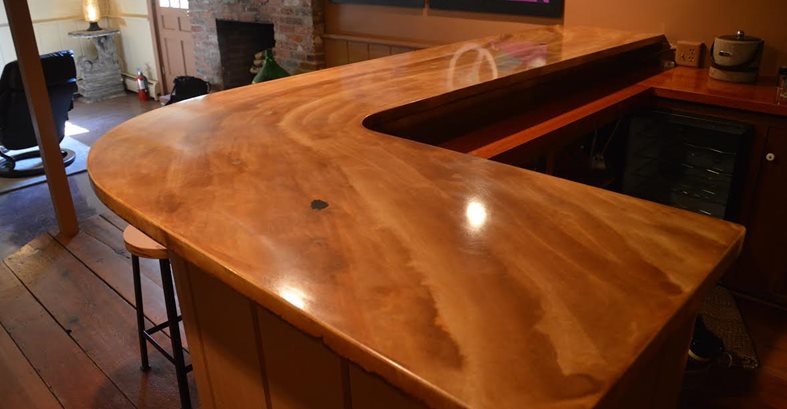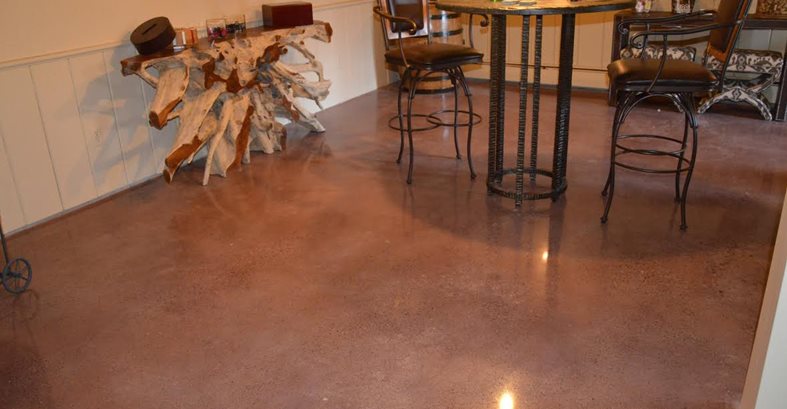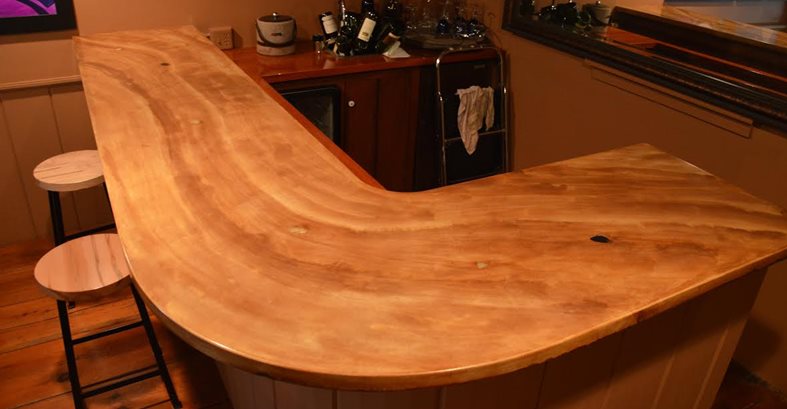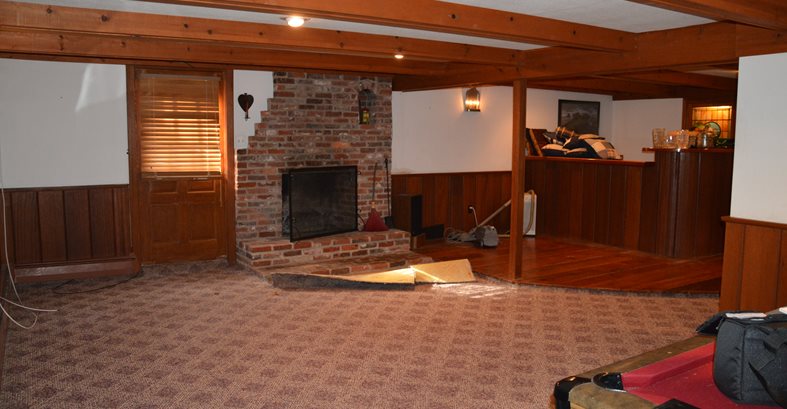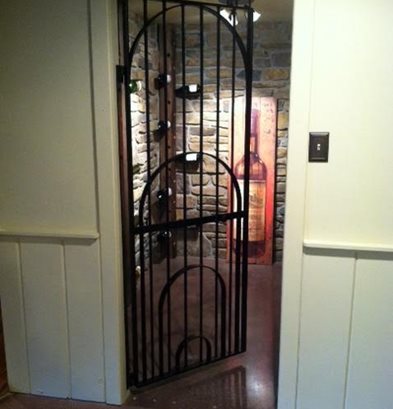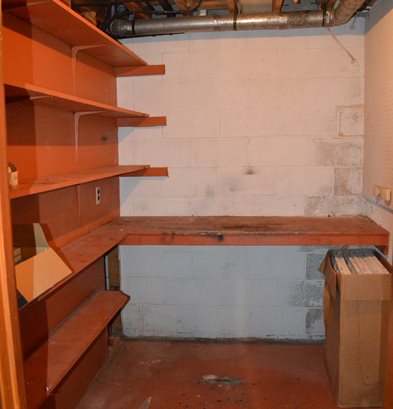- Concrete Basements Home
- Basement Construction Checklist
- Codes for Finished Basements
- Foundation Drainage and Waterproofing: How to keep below-grade spaces dry
- Enhancing & Repairing Existing Basements
- Enhancing Basement Floors: Seven reasons why you should enhance rather than cover up concrete basement floors
- Repairing Bowed Basement Walls: A carbon-fiber-reinforced grid system permanently stabilizes bowed foundation walls with minimal disruption and no excavation
Decorative Concrete for a Good Cause
A concrete bartop and polished floor turn heads and bring in donations for a hospital fundraiserYou don’t often find concrete artisans who do work pro bono. But when the incentive is to raise funds for a worthy cause, the effort and expense are well worthwhile. That was the case for interior designer Beth Mauer and her husband Gerry, owners of Liquid Stone Concrete Designs, a company specializing in decorative concrete countertops, floors and stamped concrete. Their pro bono “client” was the Bucks County Designer House, an annual fundraiser sponsored by the Village Improvement Association of Doylestown, Pa., to benefit a local hospital. This year, the event took place in a 245-year-old farmhouse that was opened to the public during the month of May to showcase the work of local designers, including Beth. Each designer was assigned a specific room in the home, and Beth’s challenge was to makeover the home’s basement.
“I chose the basement knowing that Liquid Stone could polish the floor. When I first saw the space, it had 1977 Berber carpet glued down on concrete that had been flooded at least twice and never replaced. I wanted to renovate the room from an old hang out space with a pool table into a sophisticated, more up-to-date wine and game room with a bar. I also planned to take an old utility closet with a painted concrete floor and transform it into a wine cave and cover the walls with stone veneer donated by a local stone company,” she says.
Beth has been an interior designer in Bucks County for over 30 years and Gerry is an experienced mason who fell in love with decorative concrete about 10 years ago. In 2006, Beth and Gerry pooled their talents to form Liquid Stone Concrete Designs, with the intent of specializing in artistic and decorative concrete. “I run the business, and Gerry and our assistant Arron Schopfer do all the hard work. Since they've done some work in previous designer houses, they were familiar with the protocol. Of course, they weren't happy that I 'hired' them to do the work for free,” she jokes.
However, Beth rolled up her sleeves as well for this undertaking. “Our secretary and I had the hard job of ripping up the carpet. No easy feat! There was about ½ inch of heavy-duty glue on the floor and about a zillion staples on the stairs. It took us two days just to remove the carpet,” she says.
After the carpet was up, a floor grinder was used to remove all the residual glue, and then the floor was polished and colored with concrete dye. “We used a dye in the color of saddle brown, but that came out a bit too purple for what I wanted. Gerry and Arron went back and misted over it with a walnut dye, and we got more of a burgundy color that was very appropriate for the space. The wine cave was dyed completely in walnut,” she says. After applying the dye, they polished the surface once again and applied a floor guard.
For the new bartop, Beth says the only logical choice was concrete. “I didn't want to just use granite like every other house in the country. Plus it was great advertising for us.” The L-shaped bar measures about 11 feet in length and 24 inches in width. It was made using Liquid Stone’s own glass-fiber-reinforced concrete mix and finished with a rust-colored acid stain. It was then protected with a penetrating sealer. “Gerry mixed different dilutions of stain and used them like watercolors over the whole top. He was going for a wood look and obviously succeeded, since a lot of attendees thought it was just a wood top. Had I not pointed out that it was concrete, they would have passed it by,” says Beth.
Beth admits she wouldn’t have attempted this project if the basement didn’t have direct exterior access. “The polishing machines are big and very heavy and wouldn't have made it down the steps. Normally the bartop would have weighed over 500 pounds, but since we used a GFRC formula, it weighed only 240 pounds, making it possible for three men to get the piece in on a dolly and lift it into place.”
According to Beth, Liquid Stone’s basement room transformation received rave reviews. It also served as great advertising for the company’s services. “Here in the North East, we have seen lots of flooding over the past few years and people are tired of replacing rugs and carpet in their lower levels. They are now seeing and hearing about polished concrete as an option,” she says. “Demand for our countertops has been primarily coming in from local architects, designers and contractors all looking for something different. They are tired of granite. We are inundated with new box-type housing developments and every one has granite. It's gotten ‘pedestrian' as the saying goes.”
Materials used:Concrete floor dye: Ameripolish Dye in Saddle Brown and WalnutFloor guard: Blue Concrete Concrete stain: H&C Acid Stain in Rusted FencePenetrating countertop sealer: Blue ConcreteStone wall veneer: Pinnacle Stone
Designer and concrete contractor:
Liquid Stone Concrete Designs LLC
Warminster, Pa.
Submit Your Own Project Photos
Get more: basement floor design ideas
